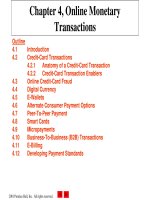Lecture Economics - Chapter 4: Elasticity
Bạn đang xem bản rút gọn của tài liệu. Xem và tải ngay bản đầy đủ của tài liệu tại đây (209.7 KB, 8 trang )
Chapter 4
Elasticity
© 2014 by McGraw‐Hill Education
1
What will you learn in this chapter?
• Concept of elasticity.
• Calculate price elasticity of demand and supply
using the mid‐point method.
• Explain how the determinants of price
elasticity of demand and supply affect the
degree of elasticity.
• Calculate cross‐price and income elasticities of
demand, and interpret the sign of the
elasticities.
© 2014 by McGraw‐Hill Education
2
What is elasticity?
• Elasticity is a measure of the responsiveness to
a change in a market condition.
• The concept applies to supply and demand.
• It measures the response to a change in:
– the price of the good.
– the price of a related good.
– income.
© 2014 by McGraw‐Hill Education
3
1
Price elasticity of demand
• The price elasticity of demand measures the magnitude
of change in the quantity demanded from a change in
its price. In other words, it estimates price sensitivity.
Price ($) 3.00
2.50
A
2.00
1. When price
Decreases by 25%...
B
1.50
D
1.00
2. …quantity
demanded
increases
by 50%.
0.50
0
5
10
15
20
Quantity of coffee (millions of cups)
© 2014 by McGraw‐Hill Education
4
Calculating price elasticity
• The midpoint method calculates the elasticity at
the midpoint of any two points. The formula is:
%∆
%∆
where point 1 is
,
/
/
/
/
and point 2 is
,
.
• The midpoint elasticity is the difference of any
two numbers divided by their average.
© 2014 by McGraw‐Hill Education
5
Active Learning: Calculating the price
elasticity of demand
Find the price elasticity of demand using the
midpoint formula for the points along a demand
curve: ($10,350) and ($20, 150).
© 2014 by McGraw‐Hill Education
6
2
Determinants of price elasticity of demand
• Consumers are more sensitive to price changes
for some goods and services than for others.
• Many factors determine consumers’
responsiveness to price changes.
– Availability of substitutes.
– Degree of necessity.
– Cost relative to income.
– Adjustment time.
– Scope of the market.
© 2014 by McGraw‐Hill Education
7
Categorizing elasticities
• All goods and services can be broadly
categorized based on elasticity.
• The main categories are:
– Elastic: A change in price causes a relatively large
percentage change in quantity demanded.
– Inelastic: A change in price causes a relatively small
percentage change in quantity demanded.
© 2014 by McGraw‐Hill Education
8
Categorizing elasticities
At the extremes, demand can be either perfectly elastic or
perfectly inelastic.
Perfectly elastic (|εd| = ∞)
Price ($)
10
Perfectly inelastic (|ε d | = 0)
Price ($)
10
D
At prices
higher than $5,
the quantity
demanded is 0.
D
5
At any
price, the
quantity
demanded
is the
same.
5
Consumers
will buy any
quantity at a
price of $5
0
5
© 2014 by McGraw‐Hill Education
10
Quantity
0
5
10
Quantity 9
3
Categorizing elasticities
Between these two extremes, the elasticities are divided into
three categories.
Elastic (|εd | >1)
Unit‐elastic (|εd | = 1)
Price ($)
Price ($)
10
9
8
7
6
5
4
3
2
1
0
…quantity
demanded
increases by 60% .
D
1 2 3 4 5 6 7 8 9 10
Quantity
10
9
8
7
6
5
4
3
2
1
0
Inelastic (|εd | < 1)
Price ($)
…quantity
demanded
increases by 40%.
D
10
9
8
7
6
5
4
3
2
1
1 2 3 4 5 6 7 8 9 10
Quantity
0
…quantity
demanded
increases by 20%.
D
1 2 3 4 5 6 7 8 9 10
Quantity
When price declines by the same amount (say 40%)…
© 2014 by McGraw‐Hill Education
10
Using price elasticity of demand
• Knowing whether the demand for a good is
elastic or inelastic is extremely useful in
business.
– Allows managers to determine whether a price
increase will cause total revenue to rise or fall.
• Total revenue is the amount that a firm
receives from the sale of goods and services.
– Total revenue (TR) equals price paid (P) multiplied
by quantity sold (Q), or TR = P x Q.
© 2014 by McGraw‐Hill Education
11
Using price elasticity of demand
An increase in price affects total revenue in two ways.
Price ($)
500
Price effect
2+3= total revenue
after the price change.
450
Quantity effect
400
350
1+2= total revenue
before the price
change.
3
300
1. As price
Increases…
250
200
150
2
1
100
2. …quantity
decreases.
50
0
© 2014 by McGraw‐Hill Education
2
4
6
8
10
12
14
D
16
18
20
Quantity
12
4
Using price elasticity of demand
The magnitude of the price and quantity effects
are determined by the elasticity of demand.
Price ($)
Price ($)
5
Price effect
5
Price effect
Quantity effect
4
Quantity effect
4
When demand is
elastic, the quantity
effect outweighs the
price effect.
3
2
3
When demand is inelastic,
the price effect outweighs
the quantity effect.
2
1
1
D
D
0
1
2
3
4
5
6 7 8 9 10
Quantity (thousands)
0
1
2
3
4
© 2014 by McGraw‐Hill Education
5 6 7 8 9 10
Quantity (thousands)
13
Active Learning: Calculating the change in
total revenue
Find the change in total revenue using the following two
points along a demand curve: ($20, 150) and ($10,350).
© 2014 by McGraw‐Hill Education
14
Using price elasticity of demand
The relationship between P, Q, TR, and εd is
summarized as follows.
Price ($)
P ($)
Q
TR ($)
50
0
0
50
45
1
45
45
40
2
80
40
35
3
105
35
30
4
120
30
25
5
125
25
20
6
120
20
15
7
105
15
10
8
80
10
5
9
45
5
0
10
0
© 2014 by McGraw‐Hill Education
Total revenue ($)
125
100
75
50
25
D
0
1 2 3 4 5 6 7 8 9 10 0
Quantity
Elastic
demand:
decreasing
price
Inelastic
demand:
decreasing
price
revenue
revenue
1 2 3 4 5 6 7 8 9 10
Quantity
15
5
Price elasticity of supply
• The concept of elasticity can also be applied to
supply.
• The price elasticity of supply measures producers’
response (in quantity) to a change in price.
– Uses same midpoint formula but replaces quantity
demanded with quantity supplied.
– Elasticity is always positive.
– Same interpretation:
• Elastic: εs >1.
• Unit Elastic: εs =1.
• Inelastic: εs <1.
© 2014 by McGraw‐Hill Education
16
Determinants of price elasticity of supply
• Producers are more sensitive to price changes
for some goods and services than for others.
• Many factors determine producers’
responsiveness to price changes.
– Availability of inputs.
– Flexibility of the production process.
– Adjustment time.
© 2014 by McGraw‐Hill Education
17
Cross‐price elasticity of demand
• The cross‐price elasticity of demand is a measure of
how the quantity demanded of one good changes when
the price of a different good changes.
• The midpoint formula calculates the elasticity between
the quantity demanded of good A and the price of good
B:
,
%∆
%∆
/
/
/
/
• The cross‐price elasticity of demand can be positive or
negative.
–
–
,
,
>0: the two goods are substitutes.
<0: the two goods are complements.
© 2014 by McGraw‐Hill Education
18
6
Income elasticity of demand
• The income elasticity of demand is a measure of how
much the quantity demanded changes in response to a
change in consumers’ incomes.
• The midpoint formula calculates the elasticity between
the quantity demanded of a good and consumer’s
income:
%∆
%∆
/
/
/
/
• The income elasticity of demand can be positive or
negative.
–
–
>0: the good is normal. If >1, then it is a luxury.
<0: the good is inferior.
© 2014 by McGraw‐Hill Education
19
Active Learning: Calculating the income
elasticity of demand
• When consumers’ income is $100, they buy 250
units of a good. When consumers’ income
increases to $200, they buy 500. Find the income
elasticity of demand using the midpoint formula.
• Is the good inferior or normal?
• Is it a luxury good?
© 2014 by McGraw‐Hill Education
20
Four measures of elasticity
Measure
Equation
% change in quantity demanded
% change in price
% change in quantity supplied
% change in price
Negative
Always
Never
Over time, for
substitutable
goods and
luxury items
Never
Always
Over time,
with flexible
production
% change in quantity demanded of A For
% change in price of B
complements
% change in quantity demanded
% change in income
© 2014 by McGraw‐Hill Education
Positive More elastic
For
inferior
goods
Less elastic
In the short
run, for unique
and necessary
items
In the short
run, with
production
constraints
For near perfect
For
substitutes
For loosely
substitutes and strong
related goods
complements
For normal
goods
For luxury items For unique
with close
and necessary
substitutes
items
21
7
Summary
• Elasticity is the first of several concepts used to
apply the concepts of supply and demand to
business and policy questions.
– Indicates the sensitivity of quantity to a change in:
• Price.
• Price of a related good.
• Income.
• The price elasticity of demand can be used to
set prices so firms can maximize revenue.
© 2014 by McGraw‐Hill Education
22
8









